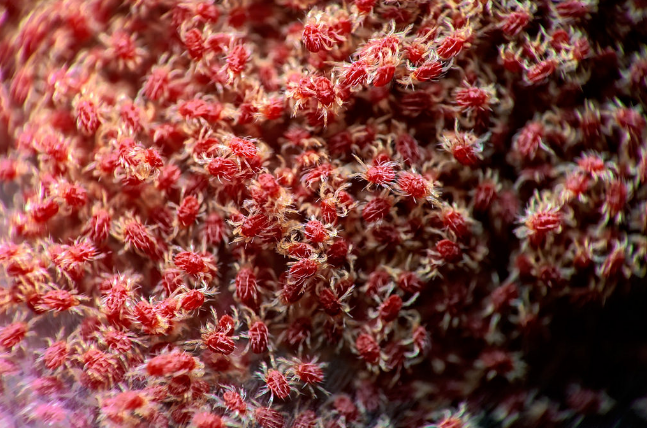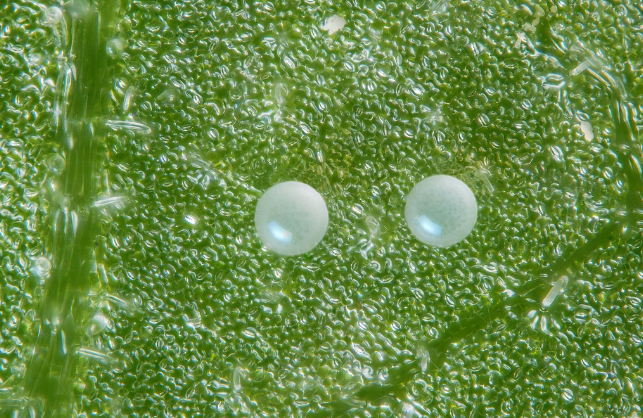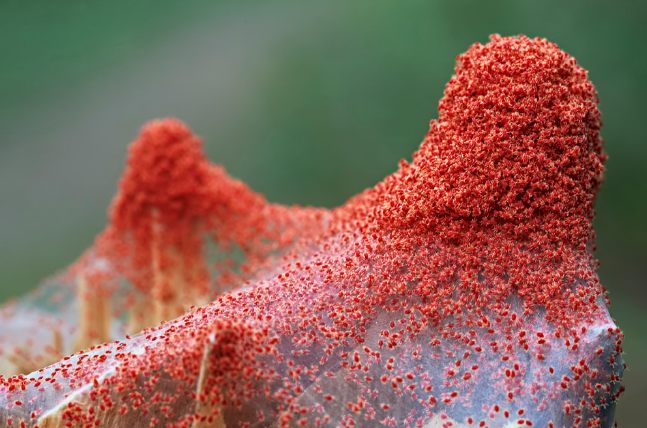Tetranychus urticae commonly known as the two spotted (Li and Margolies, 1993) or red spider mite (Hinomoto et al, 2001) (Fig 1) is a polyphagous herbivore found worldwide, (Navajas, 1998) that is known to feed on 3, 877 plant species. (Attia et al, 2013) T. urticae is able to rapidly reproduce, colonize, and adapt to new host species. (Leeuwen et al, 2013) In severe infestations this mite can completely defoliate plants; (Wood et al, 1994) causing significant yield loses to economically important crops. (Tehri et al, 2014) In Europe $1 billion US dollars is spent on pesticides yearly trying to control T. urticae outbreaks. (Leeuwen et al, 2010) However, T. urticae rapidly develops resistance to pesticides (Leeuwen et al, 2013). In 2012 T. urticae strains were present in nature that were resistant to all commercially available pesticides. (Leeuwen et al, 2013) Pesticide resistance makes T. urticae a devastating pest. When crops and orchards are sprayed with pesticides T. urticae’s predators are killed leaving T. urticae unharmed. (Gerson and Cohen, 1989) In an environment devoid of predators T. urticae is able to reproduce, disperse, and colonize new plants with increased success resulting in severe infestations in crops and orchards. (Gerson and Cohen, 1989)
(Fig 1. Left and right pictures show the red spider mite and two spotted spider mite colour morph of T. urticae respectively. Both pictures where taken by Gilles San Martin. CC BY-SA 2.0 )
T. urtiace evolves pesticide resistance when changes in its genome increases the number of expressed detoxification enzymes, causing pesticides to be metabolized before reaching their target receptor. (Leeuwen et al, 2013) Interestingly T. urticae’s ability to feed on multiple plant species may contribute to T. urticae’s ability to evolve pesticide resistance. (Dermauw et al, 2013) Though T. urticae’s preferred hosts are bean plants this mite can quickly adapt to new host species. (Fry, 1989) In a captive study where T. urticae was forced to feed on the normally toxic host tomato the number of detoxification genes expressed significantly increased after five generations. (Dermauw et al, 2013) Dermauw et al,’s (2013) study suggests adaptation to a toxic host increases detoxification gene expression and may allow T. urticae to survive pesticides. Because T. urticae rapidly reproduces and has haploid diploid sex determination where non fertilized and fertilized eggs develop into males and females respectively, (Li and Margolies, 1993)(Fig2) pesticide resistant genes are quickly selected for and spread throughout the population. (Leeuwen et al, 2013) However, many natural predators of T. urticae such as coccinellid beetles (Stethorus spp) and mites of the family Phytoseiidae are more susceptible to pesticides then T. urticae. (Gerson and Cohen, 1989)
(Fig 2. Two T. urticae eggs. Picture taken by Gilles San Martin CC BY-SA 2.0 )
T. urticae population size has been experimentally shown to be significantly smaller when predators are present. (Wood et al, 1994) Predators such as gall midge larvae (Felttiella acarisuage) feed on T. urticae’s eggs, suppressing population increase. (Mo and Liu, 2007) However, pesticides kill T. urticae’s predators. (Gerson and Cohen 1989) Synthetic pyrethroids have even been experimentally shown to inhibit the growth of the entomogenous fungus Beauveria bassiana which parasitizes T. urticae. (Gerson and Cohen 1989; Anderson and Roberts, 1983) In an environment devoid of predators T. urticae’s reproduction success increases. (Gerson and Cohen, 1989) One female T. urticae can deposit over 50 fertilized eggs (Li and Margolies, 1993) which develop into adults in 6.5 days at 30˚C. (Tehri et al, 2014) Some pesticides even positively affect T. urticae’s reproduction. (Gerson and Cohen, 1989) Fenvalerate has been shown to significantly increase the amount of eggs deposited. (Gerson and Cohen, 1989) Rapid increase in T. urticae’s population size can cause significant yield loss to economically important plants. (Tehri et al, 2014) T. urticae feeds by piercing the leaf mesophyll (Fry, 1989) and eating the chloroplast this causes leaf bronzing. (Tehri et al, 2014) (Fig 3) When the host begins to die T. urticae mated females search for a new host either by aerial dispersal or by walking. (Tehri et al, 2014; Yano, 2008)
(Fig 3. A severe infestation of T. urticae on a host plant. Photo taken by Aleksy Gnilenkov CC BY 2.0 )
Aerial dispersal allows T. urticae to spread throughout crops and orchards colonizing new hosts. (Croft and Jung, 2001) A single female is capable of starting a new colony; but predator mites such as Neoseiulus fallacis aggregate and disperse with T. urticae often driving new colonies to extinction. (Croft and Jung, 2001) However, human disturbances can interfere with predator prey interaction. (Hardman et al, 2006)The harvesting of peppermint displaces T. urticae and its predator N. fallacis to the soil. (Croft and Jung, 2001) Though recolonization quickly happens N. fallacis cannot tolerant the post-harvest arid environment and its distribution is restricted to peppermint leaves close to the soil. (Croft and Jung, 2001) T. urticae; however, can disperse and colonize anywhere, resulting in severe T. urticae infestations; (Croft and Jung, 2001)which have been reported to cause up to a 70% yield lost. (Rijal et al, 2016) In apple orchards the use of the fungicide ethylene bis dithiocarbamate (EBDC) kills the predator mites Amblyseius fallacis and T. pyri, that normally prey on T. urticae dispersing from the ground to the trees respectively. (Hardman et al, 2006) This increases T. urticae’s dispersal and colonization success resulting in severe infestations. (Hardman et al, 2006) Because pesticides result only in T. urticae outbreaks the successful control of T. urticae may require switching from a chemical to a biological management strategy. Gigon et al, (2016) showed that the predator mite Phytoseiulus macropilis could successfully control T. urticae infestations on greenhouse tomatoes if introduced immediately after T. urticae was first detected. Therefore, immediately reintroducing predators to crops and orchards that have been treated with pesticides may help to control T. urticae populations and prevent severe infestations.
In conclusion the over use of pesticides in agriculture has caused T. urticae to evolve resistance to all commercially available chemicals. (Leeuwen et al, 2013) When crops and orchards are treated with pesticides T. urticae’s natural predators are killed. (Gerson and Cohen, 1989) In the absence of natural enemies T. urticae is able to rapidly reproduce and colonize new host plants with increased success. (Gerson and Cohen, 1989) Severe T. urticae infestations completely destroy plant leaves (Wood et al, 1994) causing significantly yield loses to economically important crops and orchards worldwide. (Tehri et al, 2014) However, the reintroduction of predators to chemical treated crops and orchards may prevent severe T. urticae infestations, and be a plausible biological management strategy. (Gigon et al, 2016)





Recent Comments